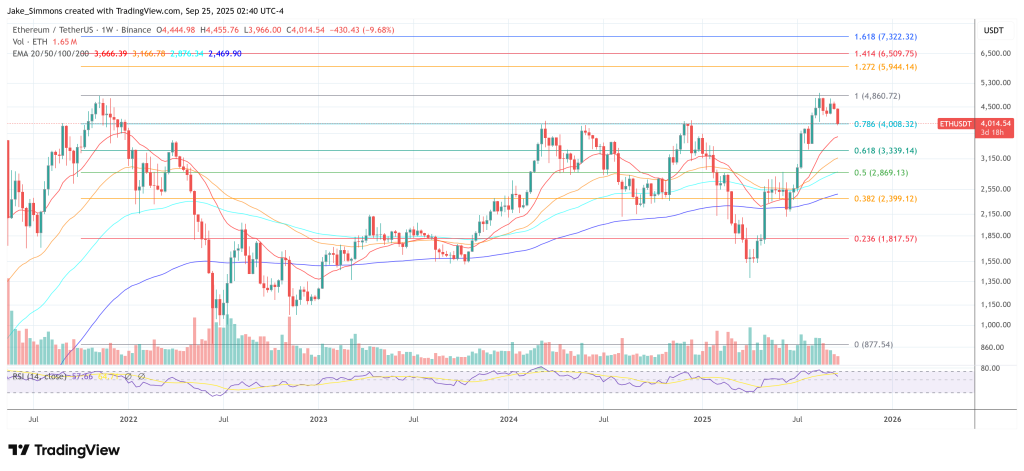VC Firm Boss Torches Tom Lee’s Ethereum Thesis as ’Retarded’ in Brutal Takedown
Wall Street's crypto clash erupts as Fundstrat's bullish Ethereum forecast gets mercilessly shredded by venture capital heavyweights.
The Contradiction
Tom Lee's optimistic Ethereum projections just got slammed by a VC firm founder who didn't mince words—calling the analysis 'retarded' in a blistering critique that's shaking crypto circles. The confrontation exposes the deepening rift between traditional financial analysts and blockchain-native investors.
Analysts Versus Builders
While Lee's team points to technical indicators and adoption metrics, the VC response highlights what they see as fundamental misunderstandings about Ethereum's real-world utility. The spat reveals how Wall Street's number-crunching approach often misses the architectural innovations driving blockchain evolution.
Market Reactions
Traders are watching the showdown closely—knowing these public disputes frequently precede significant price movements. When establishment analysts and crypto insiders collide, the volatility tends to benefit those who've actually read the whitepapers instead of just the price charts.
Another day, another reminder that in crypto, the only thing more volatile than the markets are the opinions of people who still think 'blockchain' and 'Bitcoin' are synonyms.
Is Tom Lee’s Ethereum Thesis Retarded?
Kang’s central attack targets the idea that rising tokenization and stablecoin activity should translate into outsized fee capture for Ethereum. “Since 2020, tokenized asset value and stablecoin transaction volumes have increased 100–1000x… [but] fees are practically at the same level as in 2020,” he argued. He attributed the disconnect to “Ethereum network upgrades making tx’s more efficient,” activity moving “to other chains,” and the reality that “tokenizing low-velocity assets doesn’t drive much fees.” He distilled the point with a stark comparison: “Someone could tokenize a $100m bond and if it trades once every 2 years… A single USDT WOULD generate more fees.”
The Mechanism Capital partner pushed the competitive angle further. “Most of the fees will be captured by other blockchains with stronger business development teams,” he wrote, naming “Solana, Arbitrum, and Tempo” as seeing “most of the early big wins,” and adding that “Tether is supporting two new Tether chains, Plasma and Stable,” explicitly intended to route USDT volume to Tether-controlled rails.
Kang also dismissed Lee’s “digital oil” framing as analytically hollow. “Oil is a commodity… real oil prices adjusted for inflation have been trading in the same range for over a century with periodic spikes that revert… I agree ETH could be viewed as a commodity, but that’s not bullish,” he wrote.
He extended the range analogy directly to Ether’s chart: “Looking at this chart objectively, the strongest observation is that Ethereum is in a multi-year range… we recently tapped the top of the range, failing to break resistance… I would not discount the possibility of a much longer $1,000–$4,800 range.” On relative performance, he added: “Long-term ETH/BTC is indeed in a multi-year range, but the last few years have mostly been dictated by a downtrend… The ethereum narrative is saturated and fundamentals do not justify valuation growth.”
On institutions, Kang argued that Lee’s premise—that banks and large corporates will accumulate and stake ETH to secure tokenization networks or as operating capital—misunderstands treasury behavior and value accrual. “Have large banks… bought ETH on their balance sheet yet? No. Have any of them announced plans to? Also no… Do banks stock up on barrels of gasoline because they continually pay for energy? No… Do banks buy stocks of asset custodians they use? No,” he wrote, calling the idea that staking demand from incumbents would underpin valuation a category error.
Kang’s thread culminated in a withering assessment of Ethereum’s pricing dynamics: “Ethereum’s valuation comes primarily from financial illiteracy… [which] can create a decently large market cap… But the valuation that can be derived from financial illiteracy is not infinite… Unless there is major organizational change it is likely destined to indefinite underperformance.”
Lee’s latest outlook, by contrast, has emphasized Ethereum’s suitability for Wall Street tokenization and its role as a “neutral chain,” with public targets clustered around $10,000–$12,000 by end-2025 and up to $62,500 in a favorable super-cycle.
At publication time, ETH traded NEAR $4,000.


